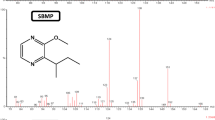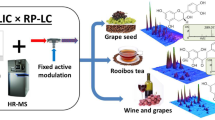Abstract
With respect to the current hypothesis that natural amino acids may serve as starting material for the biosynthesis of alkyl-methoxypyrazines, the enantiomeric distribution of the potent aroma compound 3-sec-butyl-2-methoxypyrazine (SBMP) was determined in various species using heart-cut multidimensional gas chromatography (H/C MDGC) or comprehensive two-dimensional gas chromatography (GC × GC). Complementary to an earlier described separation on octakis-(6-O-methyl-2,3-di-O-pentyl)-γ-cyclodextrin used as chiral stationary phase, we found a reversal of the elution order of SBMP enantiomers on heptakis-(2,3-di-O-methyl-6-O-tert-butyldimethylsilyl)-β-cyclodextrin, providing further confirmation options for that type of analysis. Optimization of the enantioseparation of SBMP in a single-oven H/C enantio-MDGC system involved the use of a dual-jet cryo modulator for trapping of analytes transferred from the achiral 1D column to the chiral 2D column before starting the 2D enantioseparation with an independent temperature ramp. For the enantiodifferentiation by enantio-GC × GC, the modulation period had to be significantly shortened to avoid loss of chiral resolution gained in 1D. H/C MDGC with mass spectrometric detection (MS) using selected ion monitoring (SIM) was sufficient for parts per billion level analysis, whereas H/C MDGC-MS/MS or GC × GC time-of-flight (TOF) MS were necessary for parts per trillion level analysis. In various vegetables, lady beetles and Vitis vinifera species analyzed, only (S)-SBMP was detected, supporting the hypothesis of natural amino acids serving as starting material for the biosynthesis of alkyl-methoxypyrazines.

Harmonia axyridis analyzed using headspace solid phase microextraction and enantio-GC × GC-TOF-MS







Similar content being viewed by others
References
Maga JA, Sizer CE (1973) Pyrazines in foods. Review. J Agric Food Chem 21(1):22–30
Murray KE, Whitfield FB (1975) Occurrence of 3-alkyl-2-methoxypyrazines in raw vegetables. J Sci Food Agric 26(7):973–986
Allen MS, Lacey MJ (1998) Methoxypyrazines of grapes and wines. In: ACS Symposium Series, vol 714. Chemistry of wine flavor. pp 31–38
Augustyn OPH, Rapp A, Van Wyk CJ (1982) Some volatile aroma components of Vitis vinifera cv. Sauvignon blanc. S Afr J Enol Vitic 3(2):53–60
Roujou de Boubee D, Van Leeuwen C, Dubourdieu D (2000) Organoleptic impact of 2-methoxy-3-isobutylpyrazine on Red Bordeaux and Loire wines. Effect of environmental conditions on concentrations in grapes during ripening. J Agric Food Chem 48(10):4830–4834
Hashizume K, Umeda N (1996) Methoxypyrazine content of Japanese red wines. Biosci Biotechnol Biochem 60(5):802–805
Lopez R, Gracia-Moreno E, Cacho J, Ferreira V (2011) Development of a mixed-mode solid phase extraction method and further gas chromatography mass spectrometry for the analysis of 3-alkyl-2-methoxypyrazines in wine. J Chromatogr A 1218(6):842–848
Legrum C, Gracia Moreno E, Lopez R, Potouridis T, Langen J, Slabizki P, Weiand J, Schmarr H-G (2014) Quantitative analysis of 3-alkyl-2-methoxypyrazines in German Sauvignon blanc wines by MDGC-MS or MDGC-MS/MS for viticultural and enological studies. Eur Food Res Technol doi:10.1007/s00217-014-2250-8
Legrum C, Schmarr H-G (2013) Enantioselektive Analyse von 2-Methoxy-3-sec-Butylpyrazin mittels multidimensionaler Gaschromatographie und Massenspektrometrie. Lebensmittelchemie 67(4):98–99
Koegel S, Gross J, Hoffmann C, Ulrich D (2012) Diversity and frequencies of methoxypyrazines in hemolymph of Harmonia axyridis and Coccinella septempunctata and their influence on the taste of wine. Eur Food Res Technol 234(3):399–404
Pickering GJ, Spink M, Kotseridis Y, Brindle ID, Sears M, Inglis D (2008) Morbidity of Harmonia axyridis mediates ladybug taint in red wine. J Food Agric Environ 6(3 & 4):133–137
Hashizume K, Tozawa K, Endo M, Aramaki I (2001) S-adenosyl-l-methionine-dependent O-methylation of 2-hydroxy-3-alkylpyrazine in wine grapes: a putative final step of methoxypyrazine biosynthesis. Biosci Biotechnol Biochem 65(4):795–801
Hashizume K, Tozawa K, Hiraga Y, Aramaki I (2001) Purification and characterization of a O-methyltransferase capable of methylating 2-hydroxy-3-alkylpyrazine from Vitis vinifera L. (cv. Cabernet Sauvignon). Biosci Biotechnol Biochem 65(10):2213–2219
Dunlevy JD, Dennis EG, Soole KL, Perkins MV, Davies C, Boss PK (2013) A methyltransferase essential for the methoxypyrazine-derived flavour of wine. Plant J 75(4):606–617
Dunlevy JD, Soole KL, Perkins MV, Dennis EG, Keyzers RA, Kalua CM, Boss PK (2010) Two O-methyltransferases involved in the biosynthesis of methoxypyrazines: grape-derived aroma compounds important to wine flavour. Plant Mol Biol 74(1–2):77–89
Vallarino JG, Lopez-Cortes XA, Dunlevy JD, Boss PK, Gonzalez-Nilo FD, Moreno YM (2011) Biosynthesis of methoxypyrazines: elucidating the structural/functional relationship of two vitis vinifera O-methyltransferases capable of catalyzing the putative final step of the biosynthesis of 3-alkyl-2-methoxypyrazine. J Agric Food Chem 59(13):7310–7316
Cheng TB, Reineccius GA, Bjorklund JA, Leete E (1991) Biosynthesis of 2-methoxy-3-isopropylpyrazine in Pseudomonas perolens. J Agric Food Chem 39(5):1009–1012
Leete E, Bjorklund JA, Reineccius GA, Cheng TB (1992) Biosynthesis of 3-isopropyl-2-methoxypyrazine and other alkylpyrazines: widely distributed flavor compounds. Spec Publ - R Soc Chem 95 (Bioform. Flavours):75–95
Nawrath T, Dickschat JS, Kunze B, Schulz S (2010) The biosynthesis of branched dialkylpyrazines in myxobacteria. Chem Biodivers 7(9):2129–2144
Schulz S, Dickschat JS (2007) Bacterial volatiles: the smell of small organisms. Nat Prod Rep 24(4):814–842
Bungert M, Jahns T, Becker H (2001) 2-Methoxy-3-(1′-methylpropyl)pyrazine, pea odour, from the marine bacterium Halomonas venusta. Flavour Fragr J 16(5):329–333
Mihara S, Masuda H, Nishimura O (1989) Structure-odor relationship of pyrazines and determination of the enantiomeric composition of 2-methoxy-3-(1-methylpropyl)pyrazine from galbanum oil using achiral and chiral lanthanide shift reagents. Proc - Int Congr Essent Oils, Fragrances Flavours, 11th 5:23–29
Mihara S, Masuda H, Nishimura O, Tateba H (1990) Determination of the enantiomeric composition of 2-methoxy-3-(1′-methylpropyl)pyrazine from galbanum oil using achiral and chiral lanthanide shift reagents. J Agric Food Chem 38(2):465–467
Masuda H, Mihara S (1989) Preparation and odor evaluation of both enantiomers of alkoxypyrazines. Agric Biol Chem 53(12):3367–3368
Bungert M (1999) Das Sekundärstoffprofil von ausgesuchten marinen Bakterien unter besonderer Berücksichtugung des “Erbsengeruchs” von Halomonas venusta. Universität des Saarlandes, Saarbrücken ,Germany
Harris RLN, Lacey MJ, Brown WV, Allen MS (1987) Determination of 2-methoxy-3-alkylpyrazines in wine by gas chromatography/mass spectrometry. Vitis 26(4):201–207
Sala C, Mestres M, Marti MP, Busto O, Guasch J (2002) Headspace solid-phase microextraction analysis of 3-alkyl-2-methoxypyrazines in wines. J Chromatogr A 953(1–2):1–6
Hartmann PJ, McNair HM, Zoecklein BW (2002) Measurement of 3-alkyl-2-methoxypyrazine by headspace solid-phase microextraction in spiked model wines. Am J Enol Viticult 53(4):285–288
Cullere L, Escudero A, Campo E, Cacho J, Ferreira V (2009) Multidimensional gas chromatography-mass spectrometry determination of 3-alkyl-2-methoxypyrazines in wine and must. A comparison of solid-phase extraction and headspace solid-phase extraction methods. J Chromatogr A 1216(18):4040–4045
Schmarr H-G, Ganß S, Koschinski S, Fischer U, Riehle C, Kinnart J, Potouridis T, Kutyrev M (2010) Pitfalls encountered during quantitative determination of 3-alkyl-2-methoxypyrazines in grape must and wine using gas chromatography-mass spectrometry with stable isotope dilution analysis. Comprehensive two-dimensional gas chromatography-mass spectrometry and on-line liquid chromatography-multidimensional gas chromatography-mass spectrometry as potential loopholes. J Chromatogr A 1217(43):6769–6777
Ryan D, Watkins P, Smith J, Allen M, Marriott P (2005) Analysis of methoxypyrazines in wine using headspace solid phase microextraction with isotope dilution and comprehensive two-dimensional gas chromatography. J Sep Sci 28(9–10):1075–1082
Ryona I, Pan BS, Sacks GL (2009) Rapid measurement of 3-alkyl-2-methoxypyrazine content of winegrapes to predict levels in resultant wines. J Agric Food Chem 57(18):8250–8257
Schmarr H-G, Sang W, Ganß S, Koschinski S, Meusinger R (2011) New insights into the synthesis and characterization of 2-methoxy-3-alkylpyrazines and their deuterated isotopologues. J Label Compd Radiopharm 54(8):438–440
Schmarr H-G, Ganß S, Sang W, Potouridis T (2007) Analysis of 2-aminoacetophenone in wine using a stable isotope dilution assay and multidimensional gas chromatography-mass spectrometry. J Chromatogr A 1150(1–2):78–84
Marriott PJ, Schoenmakers P, Wu Z-Y (2012) Nomenclature and conventions in comprehensive multidimensional chromatography—an update. LC-GC Eur 25(5):266, 268, 270, 272–275
Schoenmakers P, Marriott P, Beens J (2003) Nomenclature and conventions in comprehensive multidimensional chromatography. LC-GC Europe 16(6):335–336, 338–339
Krumwiede D, Mehlmann H, D’Silva K (2012) Time controlled cryogenic zone compression (T-CZC): a novel gas chromatographic tool for increasing sensitivity. Chromatogr Today 19–23
Schmarr H-G, Mosandl A, Kaunzinger A (1991) Influence of derivatization on the chiral selectivity of cyclodextrins: alkylated/acylated cyclodextrins and γ-/δ-lactones as an example. J Microcolumn Sep 3(5):395–402
Schmarr H-G, Slabizki P, Legrum C (2013) Optimization in multidimensional gas chromatography applying quantitative analysis via a stable isotope dilution assay. Anal Bioanal Chem 405(20):6589–6593
Schmarr H-G, Slabizki P, Müntnich S, Metzger C, Gracia-Moreno E (2012) Ionic liquids as novel stationary phases in gas liquid chromatography: inverse or normal isotope effect? J Chromatogr A 1270:310–317
Schmarr H-G (1992) Beiträge zur on-line LC-GC Kopplung und modifizierte Cyclodextrine als chirale stationäre Phasen in der Kapillar-GC. Dissertation, Johann Wolfgang Goethe Universität, Frankfurt am Main, Germany
Bugey A, Janin Y, Edder P, Bieri S (2013) Targeted multidimensional gas chromatography using a heart-cutting device and cryogenic focusing for the determination of benzophenone derivatives in foodstuffs. Anal Bioanal Chem 405(12):4177–4185
Shellie R, Marriott P, Cornwell C (2001) Application of comprehensive two-dimensional gas chromatography (GC × GC) to the enantioselective analysis of essential oils. J Sep Sci 24(10/11):823–830
Shellie R, Marriott PJ (2002) Comprehensive two-dimensional gas chromatography with fast enantioseparation. Anal Chem 74(20):5426–5430
Shellie R, Marriott P (2003) Opportunities for ultra-high resolution analysis of essential oils using comprehensive two-dimensional gas chromatography: a review. Flavour Fragr J 18(3):179–191
Lindström M (1991) Improved enantiomer separation using very short capillary columns coated with permethylated β-cyclodextrin. J High Resolut Chromatogr 14(11):765–767
Grob K, Neukom H-P, Schmarr H-G, Mosandl A (1990) Separation efficiency versus resolution: chiral separation of gamma lactones by capillary GC on derivatized cyclodextrin. J High Resolut Chromatogr 13(6):433–436
Bartle KD, Woolley CL, Markides KE, Lee ML, Hansen RS (1987) Rayleigh instability of stationary phase films in capillary column chromatography. J High Resolut Chromatogr Chromatogr Commun 10(3):128–136
Murphy RE, Schure MR, Foley JP (1998) Effect of sampling rate on resolution in comprehensive two-dimensional liquid chromatography. Anal Chem 70(8):1585–1594
Khummueng W, Harynuk J, Marriott PJ (2006) Modulation ratio in comprehensive two-dimensional gas chromatography. Anal Chem 78(13):4578–4587
Acknowledgments
The authors are particularly thankful to Supelco (Sigma-Aldrich) and CTC Analytics for the supply of SPME fibers as well as the ionic liquid GC column (Supelco). C. Legrum is grateful for the Ph.D. scholarship of the “Graduiertenförderung des Landes Rheinland Pfalz”. Furthermore, financial support from the Ministerium für Umwelt, Landwirtschaft, Ernährung, Weinbau und Forsten (Rheinland-Pfalz, Germany) is gratefully acknowledged.
Author information
Authors and Affiliations
Corresponding author
Additional information
This paper is dedicated to Dr. Konrad (Koni) Grob (Zürich, Switzerland) on the occasion of his 65th birthday.
Published in the topical collection Multidimensional Chromatography with guest editors Torsten C. Schmidt, Oliver J. Schmitz, and Thorsten Teutenberg.
Charlotte Legrum and Hans-Georg Schmarr contributed equally to this work.
Rights and permissions
About this article
Cite this article
Legrum, C., Slabizki, P. & Schmarr, HG. Enantiodifferentiation of 3-sec-butyl-2-methoxypyrazine in different species using multidimensional and comprehensive two-dimensional gas chromatographic approaches. Anal Bioanal Chem 407, 253–263 (2015). https://doi.org/10.1007/s00216-014-8061-8
Received:
Revised:
Accepted:
Published:
Issue Date:
DOI: https://doi.org/10.1007/s00216-014-8061-8




